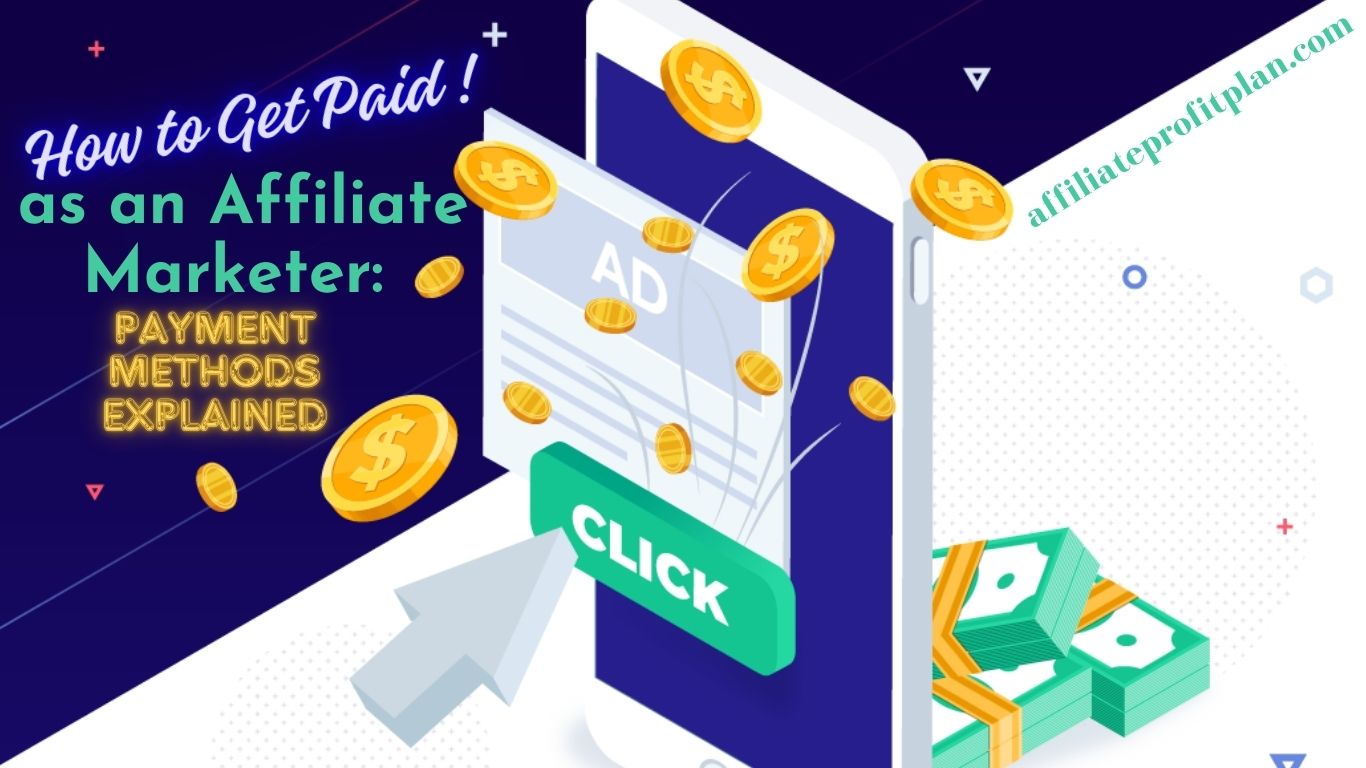Welcome to my article How to Get Paid as an Affiliate Marketer: Payment Methods Explained. If you’re diving into the world of affiliate marketing, you’ve probably realized one thing: it’s a great way to earn money online—until it’s time to get paid! After all, what good is affiliate marketing if you don’t understand how to actually collect your earnings? Whether you’re a seasoned pro or a newbie trying to figure out how to get paid for all that hard work, understanding your payment options is key. Trust us, knowing the difference between PayPal and direct bank transfers could be the difference between celebrating a payday and scratching your head wondering where your money went.
In this guide, we’ll break down everything you need to know about getting paid as an affiliate marketer. From the most popular payment methods like PayPal and bank transfers to the more modern options like cryptocurrency, we’ll explain how each method works, the pros and cons, and what might work best for you. We’ll even cover important details like payment thresholds and the nuances of payment processing times—because we know you’re probably not in the mood for surprises when it comes to your earnings. So, if you’re ready to turn your affiliate marketing hustle into cold, hard cash, keep reading!
Access My Proven Blueprint for $50-$100 Daily Income – Watch This FREE Video Now >>>

Common Affiliate Payment Models
When you start affiliate marketing, you quickly realize that not all affiliate programs are created equal, especially when it comes to how you get paid. The way you earn commissions depends on the payment model used by the affiliate program, and trust us, understanding these models is crucial if you want to make sure you’re getting the best bang for your buck. Let’s break down the most common affiliate payment models so you can choose the one that fits your strategy (and your wallet).
Cost Per Sale (CPS)
This is probably the most familiar payment model for most affiliate marketers. With CPS, you earn a commission whenever someone makes a purchase through your affiliate link. In other words, you only get paid when you successfully sell something. Sounds like a good deal, right? Well, it is—if you can drive enough sales. The commissions can range from a small percentage of a product’s price to a hefty flat fee, depending on the affiliate program. Think of it as the “classic” model of affiliate marketing, and if you’re selling physical products or digital goods, this is often your go-to.
Cost Per Click (CPC)
Next up, we’ve got Cost Per Click, or CPC, where you earn money not when someone buys, but when they click on your affiliate link. That’s right—you don’t need to close the sale to make a profit. This model works especially well if you’re driving traffic to landing pages or products that can grab attention quickly. While the payouts per click are usually smaller than CPS, it’s a more consistent way to earn money, especially if you have a high-volume website or blog. The catch? You need a steady stream of visitors to make it worth your while. But hey, who doesn’t like getting paid for just a click?
Cost Per Action (CPA)
CPA is a bit more complex but potentially more lucrative. With this model, you get paid when someone completes a specific action, like filling out a form, signing up for a newsletter, or even installing an app. It’s not as straightforward as a sale, but it’s still based on measurable activity. Some affiliate programs even pay you for just getting people to sign up for free trials or download an ebook, making it a great model if you’re promoting services, apps, or free trials. The real beauty of CPA is that you don’t need to convince someone to buy anything—you just need them to take action.
Cost Per Thousand Impressions (CPM)
CPM might sound fancy, but it’s pretty simple: you earn money based on how many people see your affiliate links, typically measured in thousands of impressions. This model is most common in display advertising, where affiliates place banner ads on their site and earn based on views. The trick here is that your traffic has to be pretty substantial to see significant earnings, but if you’re running a high-traffic blog or website, CPM can be a solid revenue stream.
Customer Lifetime Value (CLV)
Alright, now we’re getting into long-term relationships. CLV is a unique affiliate model where you earn a commission not just on a one-time sale, but on the total value a customer brings to a business over time. If you refer a customer who makes repeat purchases, you continue to earn commissions based on those future transactions. It’s like a “forever” commission, which sounds pretty sweet, right? This model works best with subscription services or products that people buy repeatedly, like software, memberships, or health supplements. The beauty of CLV is that it rewards affiliates who focus on building long-term customer relationships, not just quick sales.
Conclusion
Choosing the right affiliate payment model is a game-changer for your affiliate marketing strategy. Whether you prefer the certainty of CPS, the consistent trickle of CPC, the action-based potential of CPA, or the long-term value of CLV, there’s a model that suits your style and goals. Understanding the ins and outs of each payment structure ensures you can maximize your income and work smarter, not harder. So go ahead, explore these models, and find the one that aligns with your affiliate marketing hustle!
Top Payment Methods for Affiliate Marketers
Alright, you’ve made it this far into the affiliate marketing game, and now it’s time for the fun part—getting paid! But before you start dreaming about those affiliate commissions rolling in, you’ve got to figure out how you’re actually going to receive your hard-earned money. The good news is, there are plenty of options out there, but the bad news? Not all of them are as simple as clicking “Accept” on an online payment request. So, let’s dive into the top payment methods for affiliate marketers, and trust me, you’ll want to pick the one that works best for your needs (and your bank account).
1. PayPal: The Go-To for Many
PayPal is practically synonymous with online payments, and for good reason. It’s fast, secure, and accepted by just about every affiliate program under the sun. Whether you’re getting paid from a massive network like Amazon Associates or a smaller niche affiliate program, PayPal makes it easy to transfer funds and spend them anywhere, instantly. Plus, you don’t have to worry about your international audience—PayPal is available in over 200 countries and supports multiple currencies. The downside? There are some fees involved, especially if you’re withdrawing to your bank account or receiving payments in foreign currencies, but the convenience and global reach often make it worth the extra cost.
2. Bank Transfers (Direct Deposit): Straight to the Bank
If you’re not a fan of waiting for PayPal to process your payments or dealing with transaction fees, a good old-fashioned bank transfer might be more your speed. With direct deposit, the affiliate program wires your payment straight into your bank account, often on a regular schedule. It’s perfect for those who want the security of handling all transactions within their banking system and prefer not to deal with third-party platforms. Just be prepared for the occasional international wire fees if you’re getting paid from a foreign program. Also, keep in mind that the process can take a little longer than PayPal (usually a few business days), but for many, it’s a simple and reliable option.
3. Checks: Old-School, but Reliable
Let’s be real—receiving a check in the mail might feel a bit retro in the world of digital payments, but it’s still a valid option for many affiliate marketers. If you’re working with an affiliate network that doesn’t support PayPal or bank transfers (yes, they still exist!), you might be looking at a physical check. The benefit? No need for a PayPal account or a bank transfer—just cash it like any other check. The downside, however, is the snail-paced delivery and the fact that you’ll probably need to deposit it manually at your bank. And, oh yeah, that delightful “processing fee” that some networks tack on for paper checks. It’s an option, but not the most glamorous one.
4. Wire Transfers: Big Payments for Big Players
If you’re bringing in the big bucks and working with affiliate networks that handle high-volume payouts (think $1,000 and up), wire transfers might be your best bet. Wire transfers are super secure and fast (for large payments), and they work well for international affiliates. The downside? They can be costly—some banks charge high fees for incoming transfers, and there may also be currency conversion fees if you’re dealing with international payouts. But hey, if you’re making significant commissions, those fees might not sting as much. It’s definitely a method for those who want to avoid payment limits or slowdowns.
5. Cryptocurrency: The Cool, Future-Forward Option
Cryptocurrency—the wild card of payment methods! While it’s not as widely accepted as PayPal or bank transfers, a growing number of affiliate programs are jumping on the crypto bandwagon, paying affiliates in Bitcoin, Ethereum, or other popular cryptocurrencies. The benefits? Fast transactions, no middleman, and the potential for growth if your crypto payment appreciates in value. If you’re already into the world of crypto, this could be a no-brainer. But be aware—crypto payments come with some volatility and are still relatively niche compared to traditional methods. Plus, you’ll need to know what you’re doing to avoid losing money in transaction fees or exchange rate fluctuations.
Conclusion
Choosing the right payment method as an affiliate marketer comes down to what works best for you and your financial habits. PayPal offers convenience, bank transfers are reliable, checks are…well, still around, wire transfers are for the high rollers, and cryptocurrency is the cool, futuristic option. As with most things in affiliate marketing, it’s all about balancing speed, fees, and convenience to ensure you’re getting paid as quickly and efficiently as possible. So, take a moment, evaluate your needs, and pick the payment method that’ll help you turn all that hard work into a paycheck that’s ready for spending, investing, or, you know, the occasional treat-yourself splurge!
Payment Thresholds: What You Need to Know
When you start out as an affiliate marketer, it’s easy to get excited about your commissions rolling in—until you hit a payment threshold. Suddenly, your hard-earned cash is locked away, patiently waiting for you to reach that magical number before it can be released into your bank account or PayPal wallet. But what exactly is a payment threshold, and why does it matter? Let’s break it down, because understanding this little detail could save you from some major frustration (and maybe even a few angry emails).
Access My Proven Blueprint for $50-$100 Daily Income – Watch This FREE Video Now >>>
What is a Payment Threshold?
A payment threshold is the minimum amount of money you need to earn before an affiliate network or program will pay you. Think of it like a virtual “gatekeeper” that ensures affiliates are only paid once they’ve earned enough to make the transaction worthwhile—for both you and the company. For example, if an affiliate program sets a $50 payment threshold, that means you won’t see a dime until you’ve accumulated $50 or more in commissions. Once you hit that target, your payment will be processed.
While this may sound like a small detail, it can affect how quickly you get paid. Some networks have very low thresholds (like $10 or $20), while others can set the bar much higher (we’re talking $100 or more). So, if you’re expecting to get paid every week, but your threshold is $100, you might have to wait a bit longer to see your earnings.
Why Do Payment Thresholds Exist?
Payment thresholds exist for a few key reasons. First and foremost, they save the affiliate networks money. Processing payments (especially small ones) comes with fees—whether it’s for PayPal transactions, bank wire transfers, or even physical checks. By setting a threshold, programs can avoid losing money on administrative costs for smaller payouts. It also helps keep things simple: Instead of making tons of tiny transactions, they only need to process bigger payouts, which are more cost-effective.
In addition, thresholds protect against fraud and ensure that affiliates are genuinely contributing to the program. After all, someone who’s only made a couple of dollars is probably just dabbling in affiliate marketing, while someone who hits a $100 threshold likely has a more established presence and can be trusted with a payment.
How to Manage Your Thresholds
Now, the tricky part is how to manage these thresholds, especially if you’re just starting and cashing out on a regular basis isn’t happening just yet. There are a few ways you can handle it:
- Track Your Progress: Keep an eye on your earnings to make sure you’re hitting the threshold regularly. If you’re working with multiple affiliate programs, check how close you are to the minimum payout for each one.
- Prioritize Higher Threshold Programs: If you’re working with an affiliate program that has a high payment threshold (say, $100), you might want to prioritize networks with lower thresholds in the meantime. This way, you can get regular payouts from some programs while you work your way up with others.
- Set Realistic Expectations: If your threshold is high, be prepared for slower payouts. But don’t fret! Once you reach that threshold, the next payment should come faster, since your commissions are being “rolled over” from previous months.
- Negotiate (If You Can): Some affiliate programs are flexible, especially if you’re a high-performing affiliate. If you’ve made significant sales and consistently hit that threshold, you might be able to request a lower payment threshold to receive your funds more quickly. It never hurts to ask!
Different Programs, Different Thresholds
Affiliate programs vary widely when it comes to payment thresholds. While some networks offer incredibly low thresholds (for example, $10 or $20), others—especially larger, more established networks like Amazon Associates—may set the bar higher. Understanding the payment schedule and threshold for each program you work with will help you plan your finances and avoid any surprises. For example, if your Amazon Associates program has a $100 threshold, but you’re only pulling in $30 a month, it’ll take you quite a while to reach that payout.
Conclusion
Payment thresholds are a necessary but sometimes annoying part of the affiliate marketing process. They ensure that your affiliate network doesn’t lose money on processing small payments, and they help make sure that affiliates are genuinely committed to the program. While hitting that threshold might take time, it’s important to track your earnings, prioritize programs with lower thresholds, and manage your expectations accordingly. Once you get the hang of it, you’ll be hitting those thresholds with ease, and the payments will start flowing faster than you can say “commission check.” Keep your eye on the prize, and remember: patience is key when it comes to affiliate payouts!
The Pros and Cons of Each Payment Method
As an affiliate marketer, you’ll likely be paid in a variety of ways—each with its own set of perks and potential pitfalls. Understanding the pros and cons of each payment method can help you avoid any nasty surprises when you finally see those commissions rolling in. Whether you’re getting paid via PayPal, bank transfer, or even crypto (yes, really), it’s important to weigh the good and the not-so-good before deciding which method works best for you. So, let’s dive into the pros and cons of the most common affiliate payment methods, shall we?
1. PayPal: Fast and Convenient, But with a Few Bumps Along the Way
PayPal—the king of online payments. It’s fast, it’s widely accepted, and it makes getting paid feel like a breeze. But, as with all things in life, there’s a catch (isn’t there always?).
Pros:
- Fast and Secure: Payments through PayPal usually hit your account within a few days. No need to wait for checks in the mail or bank transfers to clear.
- Globally Accepted: Whether you’re working with U.S.-based programs or international networks, PayPal is the preferred method for many affiliate marketers worldwide. You can also receive payments in different currencies, making it ideal for global operations.
- User-Friendly: Managing your payments is straightforward. You can track them easily and transfer funds between PayPal and your bank account with minimal effort.
Cons:
- Fees, Fees, and More Fees: PayPal may be convenient, but it doesn’t come cheap. Expect fees for international payments, currency conversions, and receiving payments for goods and services. These fees can eat into your earnings if you’re not careful.
- Account Freezes and Holds: PayPal has been known to freeze accounts or hold funds if there’s any suspicion of fraud or unusual activity. While this is a safeguard, it can be a headache if you’re in the middle of a payout.
- Not Ideal for Larger Amounts: While PayPal is great for small to mid-sized payments, it can be less desirable for larger sums, especially with the associated fees. If you’re pulling in big affiliate commissions, you might want to consider other options.
2. Bank Transfers: Reliable, But Not Always Fast
Direct bank transfers are the gold standard for many affiliate programs. They’re secure, dependable, and don’t involve third-party platforms. However, they come with a few trade-offs, especially when it comes to speed.
Pros:
- Reliability: Bank transfers are generally secure and straightforward. Once the money is in your account, it’s yours—no third parties to deal with.
- No Fees for Domestic Transfers: If you’re working with domestic affiliates, there are usually no fees involved in bank transfers. This can be a huge plus for affiliate marketers who want to keep all of their earnings.
- Great for Larger Amounts: Bank transfers work well for large payouts since there’s no PayPal limit to hit, and they don’t charge hefty fees for big sums. If you’re bringing in the big bucks, this method is a solid choice.
Cons:
- Slower Processing: Unlike PayPal, bank transfers can take several business days to process. So, if you’re used to getting paid in 24 hours, you might find yourself twiddling your thumbs while you wait.
- Fees for International Transfers: If you’re dealing with international affiliates, bank transfers can get expensive. You might face hefty fees for currency conversion and international transfers, which can significantly reduce your payout.
- Less Convenient: While secure, bank transfers aren’t as instant or flexible as PayPal. You’ll need to wait for the money to hit your bank, and it can be harder to track payments in real-time.
3. Checks: A Blast from the Past
Receiving a physical check in the mail feels like an old-school throwback, but it’s still a payment method offered by some affiliate programs. While it might sound charming, checks come with a whole host of issues that can make you reconsider the nostalgia.
Pros:
- Low Transaction Fees: Unlike PayPal and bank transfers, receiving a check doesn’t come with transaction fees. You simply cash it in or deposit it into your bank account.
- Good for Those Who Don’t Want Digital Payments: If you prefer to keep things offline or don’t trust digital payments, checks provide a way to receive your earnings without dealing with third-party platforms.
Cons:
- Slower Than a Snail on Vacation: Let’s be honest—waiting for a check to arrive in the mail takes forever. Then, you’ll need to deposit it, which could take even longer to clear. If you’re used to fast payments, checks will feel like an eternity.
- Lost or Stolen Checks: You run the risk of checks getting lost in the mail or stolen. While you can request a replacement, this just adds unnecessary delays and headaches to the process.
- Paperwork: Getting a check involves dealing with paperwork and bank visits. Not exactly the most convenient or modern way to handle payments, especially when there are faster options available.
4. Wire Transfers: Big Payments, Big Fees
Wire transfers are the choice for affiliate marketers who are dealing with substantial commissions and need a secure, direct way to receive large payments. If you’re raking in the cash, wire transfers can be your best friend, though they come with their own baggage.
Pros:
- Fast for Large Amounts: Wire transfers can process large sums quickly and securely. They’re ideal for affiliates making big-ticket commissions or who need a reliable method for receiving large payments.
- Great for International Payments: If you’re working with global affiliates, wire transfers can handle international payments smoothly, with the ability to send funds across borders in various currencies.
Cons:
- Expensive Fees: Wire transfers aren’t cheap. You’ll likely face hefty fees for both sending and receiving payments, especially when dealing with international transactions. For large sums, this might be worth it, but it can eat into smaller commissions.
- Not Ideal for Small Amounts: If you’re dealing with low to mid-sized payments, wire transfers might not be worth the fees. You’re better off with PayPal or direct bank transfers if the amounts are smaller.
5. Cryptocurrency: The Cool, But Risky Option
Crypto payments are making waves in the affiliate marketing world. Paying affiliates in Bitcoin or Ethereum is becoming increasingly common, especially with digital-focused programs. It’s quick, futuristic, and—well—cool. But is it the right choice for you?
Pros:
- Fast and Low Fees: Cryptocurrencies can be sent almost instantly and with low fees, making it a good option for affiliate marketers who want to avoid the costs and delays of traditional payment methods.
- Potential for Value Increase: If you’re receiving crypto as payment, there’s a chance that the value of your earnings could increase over time as the market fluctuates. Pretty exciting, right?
Cons:
- Volatility: Cryptocurrencies are notoriously volatile. While you might see a surge in value, there’s just as much risk that the value will drop. This can be a gamble if you’re relying on stable income.
- Learning Curve: If you’re new to crypto, the whole process can be confusing. From setting up a wallet to converting your earnings into cash, it requires some technical know-how.
Conclusion
There’s no one-size-fits-all solution when it comes to affiliate marketing payments. Each method comes with its own set of pros and cons, from the speed and convenience of PayPal to the reliability of wire transfers. It all boils down to what you’re looking for: Do you want fast payments? Low fees? Big payouts? Once you weigh the advantages and disadvantages of each method, you’ll be better prepared to choose the one that fits your affiliate marketing business like a glove. Happy earning—and remember, getting paid is half the fun!
How to Set Up Your Payment Method as an Affiliate Marketer
Setting up your payment method as an affiliate marketer is like choosing the right seat on a roller coaster—you want to be comfortable, secure, and ready for the ride! After all, you’re doing the hard work to drive traffic, make sales, and build your affiliate empire, so you definitely want to ensure your earnings are easy to access. The good news is that setting up your payment method isn’t complicated, but there are a few important steps to follow to make sure the process goes smoothly. So, let’s break it down and get you ready to cash in on those commissions!
1. Choose Your Payment Method
Before you can start collecting those affiliate commissions, you’ve got to pick how you’ll actually get paid. As an affiliate marketer, you’ll typically be offered several payment methods, including PayPal, direct bank transfer, checks, wire transfers, or even cryptocurrency. The key is choosing one that’s not only convenient for you but also supported by the affiliate program you’re working with.
Tip: Make sure to read the payment terms for each affiliate program. Some may offer a range of options, while others might be more limited. For example, if you’re working with a program that only offers PayPal or direct deposit, make sure you’re ready to roll with one of those choices.
2. Set Up Your Account with the Payment Processor
Once you’ve decided on a payment method, it’s time to set up an account with the payment processor. If you’re using PayPal, for instance, you’ll need to create a PayPal account if you don’t already have one. The process usually involves providing your email address, linking a bank account or credit card, and verifying your identity.
For bank transfers, you’ll need to provide your bank account details to the affiliate program so they can send payments directly to your account. This is usually a straightforward process, but it’s important to double-check that your details are correct to avoid any delays.
Tip: Keep your account details updated, especially if you switch banks or change your PayPal email. You don’t want to miss out on your hard-earned commissions because of a minor oversight!
3. Link Your Payment Method to the Affiliate Program
Now comes the fun part—linking your payment method to your affiliate program! Most affiliate programs will have a dedicated payment section in their dashboard, where you’ll input your payment details. This is where you’ll tell them how you want to get paid, and in some cases, you may need to provide additional tax or identification information.
Whether you’re using PayPal, a bank account, or crypto, the process is usually simple, but don’t rush through it. Make sure that all your information is accurate. If you make a mistake in your payment details, you could be looking at some frustrating delays or even payment rejections.
Tip: Some programs require tax forms (like a W-9 for U.S.-based marketers) to ensure compliance. Be sure to fill out any necessary forms so you don’t hit a payment roadblock later.
4. Check the Minimum Payment Threshold
Every affiliate program has a minimum payment threshold, which is the minimum amount of money you need to earn before you can request a payout. For example, some programs have a threshold of $50, meaning you must earn at least $50 before you can get paid. Other programs might require $100 or more.
It’s a good idea to check the threshold before you get too excited about cashing out. You don’t want to hit that sweet spot only to realize you need a few more bucks to trigger the payout. Most programs will notify you once you’ve hit the threshold, so you won’t be left wondering when you’re getting paid.
Tip: If you’re getting close to the threshold, consider tracking your earnings carefully so you can plan when to request a payment. It’s like knowing when to pop the champagne—timing is everything!
5. Review Payment Schedules and Fees
Once you’ve linked your payment method, it’s important to review the payment schedule for each affiliate program. Some programs pay on a monthly basis, while others may pay bi-weekly, or even quarterly. Understanding the payment schedule will help you plan ahead and avoid any surprises.
Additionally, many payment methods come with fees, whether it’s PayPal taking a cut of your earnings or a wire transfer fee for international payments. Make sure you’re aware of any fees that might be deducted from your payout. A little knowledge here can save you from a sudden shock when you see the final amount.
Tip: Some programs will let you choose between different payment methods (like PayPal vs. direct deposit) based on the payment schedule or fees. If you want to avoid fees, bank transfers might be the way to go. If you’re in a hurry, PayPal can get your money faster—just be mindful of those pesky transaction costs!
6. Monitor Your Payments and Address Issues
Once your payment method is set up and you’re receiving those sweet commissions, it’s important to keep track of everything. Check your affiliate dashboard regularly to see when payments are due or when they’ve been processed. Some platforms will give you real-time updates on your payment status, while others may only notify you when a payment has been successfully sent.
If you run into any issues—whether it’s a delayed payment or an error in your account details—don’t hesitate to reach out to the affiliate program’s support team. The earlier you address any problems, the faster they can be resolved.
Tip: Keep a record of all your payments and transactions for tax purposes and peace of mind. It’s a good habit that will make your life much easier when tax season rolls around.
Conclusion
Setting up your payment method as an affiliate marketer is one of those tasks that might seem tedious, but trust us, it’s worth the effort. Once you’ve chosen the right method and linked it to your affiliate program, you’ll be all set to start seeing those commissions roll in! Just make sure your details are up to date, your payment thresholds are clear, and you’re aware of any associated fees. With the right setup, you’ll be able to focus on what matters most—creating great content and raking in those affiliate earnings. Happy earning!
Conclusion: Get Paid, Stay Paid, and Keep Hustling!
There you have it! Setting up your payment method as an affiliate marketer may seem like a small step, but it’s a crucial one in ensuring that your hard work and marketing genius actually pays off (literally). Whether you’re getting paid via PayPal, bank transfer, or good ol’ cryptocurrency, knowing how to set it up and keep everything running smoothly is essential to sustaining your affiliate marketing career.
Access My Proven Blueprint for $50-$100 Daily Income – Watch This FREE Video Now >>>
By now, you should have a solid understanding of the different payment methods available, the importance of payment thresholds, and the best practices for managing your payouts. The key takeaway? Make sure your payment details are accurate, stay on top of your earnings, and choose the method that works best for your lifestyle and business goals. Trust us, there’s nothing worse than waiting weeks to be paid, only to realize your bank account info was typed in wrong!
So, whether you’re a seasoned pro or a newbie just starting to rake in your first affiliate commissions, remember that getting paid should be easy, hassle-free, and—dare we say it—exciting! This is the part where the money you’ve earned actually hits your account, and that’s a sweet victory worth celebrating.
Now that you’ve got your payment methods all set up and your process streamlined, it’s time to focus on what really matters: scaling your affiliate business, testing new strategies, and most importantly, enjoying the fruits of your labor. Keep hustling, keep tracking your earnings, and before you know it, you’ll be rolling in those affiliate commissions faster than you can say “passive income.” Happy earning, and may your payments be timely and your commissions high!
Thanks a lot for reading my article on “How to Get Paid as an Affiliate Marketer: Payment Methods Explained“ till the end. Hope you’ve helped. See you with another article.










